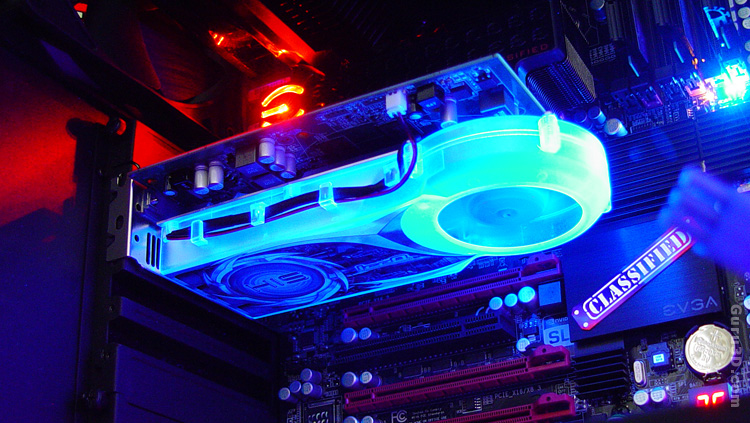The Radeon HD 5670
The Radeon HD 5670
So we've seen and explained the entire series Radeon 5000 series to date over the past couple of months. AMD's ATI is on a roll with cards at 1600 shader processors, 800 shader processors, and now thus the 5600 series with still have no less than 400 shader processors. ATI is keeping that oh so important count rather high for a budget product in order to stay on top of the game, they clearly want to dominate in all segments. And that's good as it is pushing the overall performance of graphics cards forward in a very fast pace. But let's have a look at the overall specs and also let's place them in a table to see and understand a little better what is going on. First a photo though, heck you need to see what we write about right ?
The GPU codename is Redwood is again based on the 40nm manufacturing node and is intended for the mass market. You'll see several SKUs coming from this 40 nm chip namely Redwood XT and PRO, which will replace the Radeon HD 4770 and 4670. A second similar chip yet lower specced will be called Redwood PRO and will replace the Radeon HD 4650.
Let's have a look at some of the Redwood XT which we are testing today, the Radeon HD 5670 specs at a glance:
|
Process |
40nm |
|
Transistors |
627M |
|
Engine Clock |
775 MHz |
|
Stream Processors |
400 |
|
Compute Performance |
620 GFLOPS |
|
Texture Units |
20 |
|
Texture Fillrate |
15.5 GTexels/s |
|
ROPs |
8 |
|
Pixel Fillrate |
6.2 Gpixel/s |
|
Z/Stencil |
24.8 GSamples/s |
|
Memory Type |
GDDR5 |
|
Memory Clock |
1000 MHz |
|
Memory Data Rate |
4 Gbps |
|
Memory Bandwidth |
64 GB/s |
|
Typical Board Power |
61W |
|
Idle Board Power |
14W |
As you can see we stumble into 400 shader processors tied to 8 ROP units and 20 texture units. Now, considering this is going to be a sub 100 USD card, we do feel we'll be getting value for money as we get to have 620 GFlops of compute performance. The GPU is tied to128-bit GDDR5 memory allowing a nice 64GB/s bandwidth as it is clocked at 4000 MHz (1000 MHz QDR).
| Radeon HD 5670 | Radeon HD 5750 | Radeon HD 5770 | Radeon HD 5870 | |
| Process | 40nm | 40nm | 40nm | 40nm |
| Transistors | 627M | 1.04B | 1.04B | 2.15B |
| Core Clock | 775 MHz | 725 MHz | 850 MHz | 850 MHz |
| Shader Processors | 400 | 720 | 800 | 1600 |
| Compute Performance | 620 GFLOPs | 1.008 TFLOPs | 1.36 TFLOPs | 2.72 TFLOPs |
| Texture Units | 20 | 36 | 40 | 80 |
| Texture Fillrate | 15.5 GTexels/s | 25.2 GTexels/s | 34 GTexels/s | 68.0 GTexels/s |
| ROPs | 8 | 16 | 16 | 32 |
| Pixel Fillrate | 3.2 GPixels/s | 11.2 GPixels/s | 13.6 GPixels/s | 27.2 GPixels/s |
| Z/Stencil | 24.8 GSamples/s | 44.8 GSamples/s | 54.4 GSamples/s | 108.8 GSamples/s |
| Memory Type | GDDR5 | GDDR5 | GDDR5 | GDDR5 |
| Memory Clock | 1000 MHz | 1150 MHz | 1200 | 1200 MHz |
| Memory Data Rate | 4.0 Gbps | 4.6 Gbps | 4.8 Gbps | 4.8 Gbps |
| Memory Bandwidth | 64 GB/s | 73.6 GB/s | 76.8 GB/s | 153.6GB/s |
| Maximum Board Power (TDP) | 61W | 86W | 108W | 188W |
| Idle Board Power | 14W | 16W | 18 | 27W |
Power consumption wise these puppies are going to shine, not even a 6-pin power cable connector was needed as the peak wattages are well below the 75 Watt PCIe slot limitation. The maximum wattage (TDP) is just 61 watts and when the card is idling it will use up only 14W of power thanks to many clever power saving scheme's.
In IDLE the GPU will clock down and lower its voltages on both GPU and memory. Have a look:
| GPU | Radeon HD 4870 | Radeon HD 5750 | Radeon HD 5770 | Radeon HD 5670 |
| Max. Board Power (TDP) | 160W | 86W | 108W | 61 |
| Idle Board Power | 90W | 16W | 18W | 14 |
The 5670 achieves a low 14W IDLE power consumption by clocking down in several power stages. Thus a low engine (core) clock frequency with lowered voltages and lower GDDR5 memory power. Clocked down the GPU runs 157 MHz and the memory 300 MHz coming from 775 MHz and 1000 MHz (QDR) respectively.

